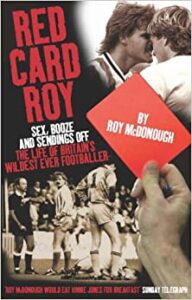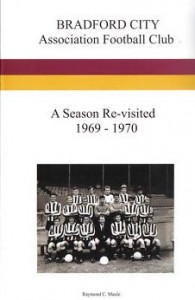Book Review: Red Card Roy: Sex, booze and early baths – the life of Britain’s wildest-ever footballer by Roy McDonough with Bernie Friend

If ever there was a book which delivered based on its title, then this is it. As the Ronseal advert of the 1990’s famously proclaimed, “it does what it says on the tin.”
This rumbustious roller-caster of a story is without doubt a page turner and details the career of Roy McDonough who was good enough to score in the top-flight for Birmingham City, but then found himself careering around the lower professional ranks with clubs including Cambridge United, Colchester United, Exeter City, Southend United and Walsall.
One of the overriding observations as a reader and which McDonough discusses in the Epilogue, is how different his career could have been, with a number of key incidents shaping the eventual path of his years in the game.
At sixteen and on the books of Aston Villa, McDonough received a six month ban from the game after assaulting the referee, effectively ending his association with the Villa Park club. However, he was taken on by Birmingham City and after signing professionally made a couple of appearances at the end of the 1976/77 season, scoring in the final day of the campaign at QPR. His expected progression into a first-team regular in the following season never materialised and frustrated by the lack of opportunities moves onto Walsall, just as the striking pair at Birmingham are injured which would have seen McDonough back playing in the First Division.
The growing resentment and frustration at having missed out on playing in the top-flight and an unhappy season at Chelsea after leaving Walsall, saw McDonough increasingly seek comfort in ‘booze and birds’ and characterised his playing career as he had spells with Southend United (twice), Colchester United (twice), Exeter City and Cambridge United. Despite the excesses of his social life, McDonough comes across as a player who gave nothing less than 100% when crossing the white line, gaining cult status at Roots Hall and Layer Road and indeed had success earning promotions with Walsall and Southend United as a player and promotion and an FA Trophy win at Wembley with Colchester United as player-manager.
McDonough was undoubtedly a centre-forward and occasional centre-half in the old style of somebody who put themselves about and his physical approach to the game led to his record number of 22 red cards. As on the pitch, this book pulls no punches and reputations of some of the biggest names in football are scattered to the winds. For example, in his career McDonough was managed by Sir Alf Ramsey (at Birmingham City), Sir Geoff Hurst (at Chelsea) and Bobby Moore (at Southend United), yet it is only the England skipper Moore who emerges with any real respect.
This is a book written in the language of the dressing room so if you are looking for a read that is PC then this particular story isn’t for you. Ultimately, it is a tale of a player and a game from a different era and is about as far away from the sanitised product that is the Premier League as you can get.
.
